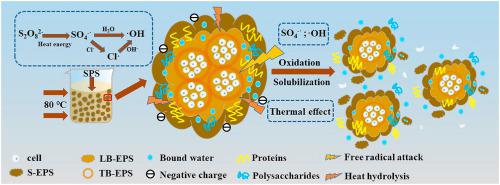Journal of Environmental Management ( IF 8.0 ) Pub Date : 2021-01-05 , DOI: 10.1016/j.jenvman.2020.111899 Shuyu Ruan , Jing Deng , Anhong Cai , Shengnan Chen , Yongqing Cheng , Jun Li , Qingsong Li , Xueyan Li

|
The mass production of waste activated sludge in wastewater treatment plants may lead to environmental pollution and sludge dewatering is an essential process during its treatment. The oxidation of extracellular polymeric substances (EPS) was the core step to achieve deep sludge dewatering. In this study, thermally-activated sodium persulfate (SPS) process was managed to improve the dewaterability of waste activated sludge (WAS) and its internal mechanism was systematically elaborated. Experimental results showed that with 2.0 mmol/g VSS SPS at 80 °C, capillary suction time (CST) was roughly 59.74% of that in raw sludge. Under this condition, 14.66 ± 0.10 × 1011 kg/m of specific resistance to filtration (SRF) and 61.8% ± 0.1% of water content (WC) was determined, respectively. A solubilization/oxidation process was proposed to unravel the mechanism of the enhanced dewaterability of WAS in thermally-activated SPS process. Mild temperature efficiently disrupted the sludge flocs and broke cell walls, releasing large amounts of EPS into bulk phase. Meanwhile, mild temperature accelerated the decomposition of SPS to generate sulfate radicals (SO4 −) and hydroxyl radicals (
−) and hydroxyl radicals ( OH) for oxidizing EPS, facilitating the conversion of bound hydrated water into free water and achieving solid-water separation. The higher reaction temperature favored sludge dewatering, whereas overdosing SPS posed no significant impact. Further analysis illustrated that tyrosine protein-like, tryptophan protein-like, fulvic acid-like and humic acid-like substances in various EPS fractions together exerted the influence on sludge dewatering. Furthermore, the synergy process could alter the secondary structure of protein, which caused a loose structure of EPS and the exposure of hydrophobic sites, facilitating the dehydration of sludge flocs. The details of how thermally-activated SPS process enhanced sludge dewaterability provided the theoretical and technical basis for the application of the process under a real-world situation.
OH) for oxidizing EPS, facilitating the conversion of bound hydrated water into free water and achieving solid-water separation. The higher reaction temperature favored sludge dewatering, whereas overdosing SPS posed no significant impact. Further analysis illustrated that tyrosine protein-like, tryptophan protein-like, fulvic acid-like and humic acid-like substances in various EPS fractions together exerted the influence on sludge dewatering. Furthermore, the synergy process could alter the secondary structure of protein, which caused a loose structure of EPS and the exposure of hydrophobic sites, facilitating the dehydration of sludge flocs. The details of how thermally-activated SPS process enhanced sludge dewaterability provided the theoretical and technical basis for the application of the process under a real-world situation.
中文翻译:

在温和的温度下通过热活化的过硫酸盐氧化来提高废活性污泥的脱水能力
废水处理厂中大量生产的废活性污泥可能会导致环境污染,污泥脱水是其处理过程中必不可少的过程。细胞外聚合物(EPS)的氧化是实现深度污泥脱水的核心步骤。在这项研究中,通过热活化过硫酸钠(SPS)工艺来改善废物活性污泥(WAS)的脱水性,并系统地阐述了其内部机理。实验结果表明,在80°C下使用2.0 mmol / g VSS SPS时,毛细抽吸时间(CST)约为原污泥中毛细抽吸时间的59.74%。在此条件下, 滤水比电阻(SRF)为14.66±0.10×10 11 kg / m,含水量为61.8%±0.1%(W C)分别确定。提出了一种增溶/氧化过程来揭示热活化SPS过程中WAS增强的脱水性的机理。温和的温度有效地破坏了污泥的絮凝物并破坏了细胞壁,从而释放了大量的EPS进入本体相。同时,温和的温度加速SPS的分解,以生成硫酸自由基(SO 4  - )和羟基自由基(
- )和羟基自由基( OH)用于氧化EPS,促进结合的水合水转化为游离水并实现固水分离。较高的反应温度有利于污泥脱水,而过量加入SPS则没有明显影响。进一步的分析表明,不同EPS组分中的酪氨酸蛋白样,色氨酸蛋白样,黄腐酸样和腐殖酸样物质共同对污泥脱水产生影响。此外,协同作用过程可能会改变蛋白质的二级结构,从而导致EPS的结构松散和疏水位点的暴露,从而促进污泥絮凝物的脱水。热活化SPS工艺如何提高污泥脱水能力的细节为该工艺在现实世界中的应用提供了理论和技术基础。
OH)用于氧化EPS,促进结合的水合水转化为游离水并实现固水分离。较高的反应温度有利于污泥脱水,而过量加入SPS则没有明显影响。进一步的分析表明,不同EPS组分中的酪氨酸蛋白样,色氨酸蛋白样,黄腐酸样和腐殖酸样物质共同对污泥脱水产生影响。此外,协同作用过程可能会改变蛋白质的二级结构,从而导致EPS的结构松散和疏水位点的暴露,从而促进污泥絮凝物的脱水。热活化SPS工艺如何提高污泥脱水能力的细节为该工艺在现实世界中的应用提供了理论和技术基础。











































 京公网安备 11010802027423号
京公网安备 11010802027423号